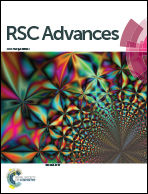Study on the structural design and performance of novel braid-reinforced and thermostable poly(m-phenylene isophthalamide) hollow fiber membranes†
Abstract
Novel braid-reinforced (BR) and thermostable poly(m-phenylene isophthalamide) (PMIA) hollow fiber membranes comprising reinforced braids and a separation layer were prepared by a dry–wet spinning process for the first time. The effects of PMIA concentration and the braid composition on the structure and performance of the BR PMIA hollow fiber membranes were investigated. Field emission scanning electron microscopy (FESEM) was used to observe the morphologies of the BR PMIA hollow fiber membranes. An increase in PMIA concentration resulted in an increase of the protein rejection rate and a decrease in the pure water flux. The higher flux recovery rate indicated that the BR PMIA membranes had excellent antifouling property compared to commercial PVDF membranes. In the BR PMIA membranes existed favorable interfacial bonding between the separation layer and the reinforced braids as the tensile strength of the BR PMIA membranes exceeded 170 MPa. Moreover, when the operating temperature was increased from 25 °C to 90 °C, the water flux increased more than two-fold with stable ink solution rejection, which showed an excellent thermal stability.



 Please wait while we load your content...
Please wait while we load your content...